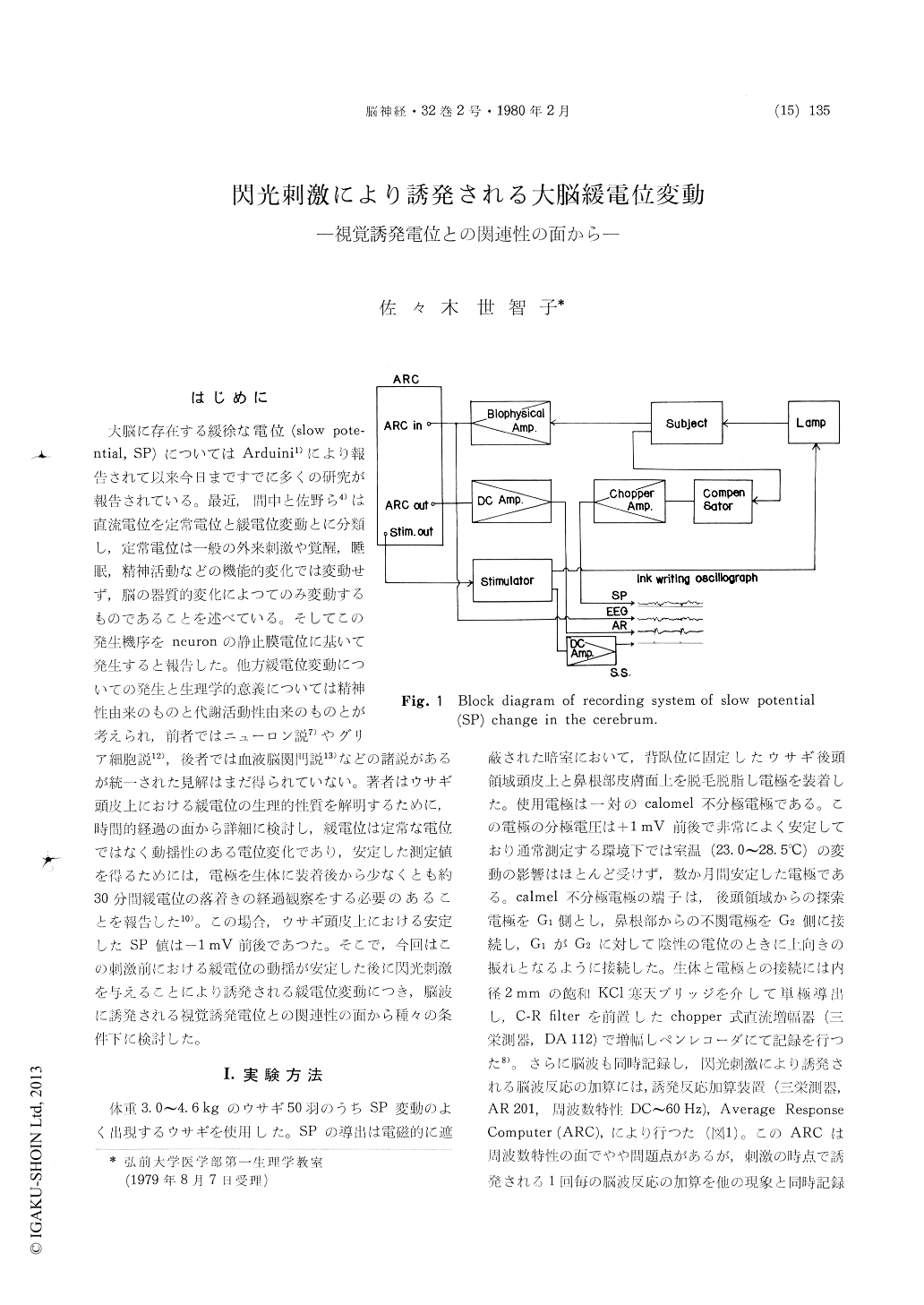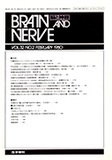Japanese
English
- 有料閲覧
- Abstract 文献概要
- 1ページ目 Look Inside
はじめに
大脳に存在する緩徐な電位(slow pote—ntial,SP)についてはArduini1)により報告されて以来今日まですでに多くの研究が報告されている。最近,間中と佐野ら4)は直流電位を定常電位と緩電位変動とに分類し,定常電位は一般の外来刺激や覚醒,睡眠,精神活動などの機能的変化では変動せず,脳の器質的変化によつてのみ変動するものであることを述べている。そしてこの発生機序をneuronの静止膜電位量に基いて発生すると報告した。他方緩電位変動についての発生と生理学的意義については精神性由来のものと代謝活動性由来のものとが考えられ,前者ではニューロン説7)やグリア細胞説12),後者では血液脳関門説13)などの諸説があるが統一された見解はまだ得られていない。著者はウサギ頭皮上における緩電位の生理的性質を解明するために,時間的経過の面から詳細に検討し,緩電位は定常な電位ではなく動揺性のある電位変化であり,安定した測定値を得るためには、電極を生体に装着後から少なくとも約30分間緩電位の落着きの経過観察をする必要のあることを報告した10)。この場合,ウサギ頭皮上における安定したSP値は−1mV前後であつた。そこで,今回はこの刺激前における緩電位の動揺が安定した後に閃光刺激を与えることにより誘発される緩電位変動につき,脳波に誘発される視覚誘発電位との関連性の面から種々の条件下に検討した。
It has been reported that the photic driving and photically evoked EEG responses are elicited by rhythmic flash stimulation. On the other hand, the slow potential (SP) in the cerebrum was also elucidated to be shifted negatively by flash stimula-tion. There are not yet clarified, however, the generating mechanism and physiological signifi-cance of the cerebral SP changes caused by flash stimulation. It seems to be very interesting to clarify whether this negative shift of the cerebral SP changes during rhythmic flash stimulation is related to any component of photically evoked EEG responses or not. The present experiments were performed to study this problem from the stand-point of the frequency and intensity of flash stimu-lus delivered in unanesthetized or moderately nembutalized conditions.
The SP changes between the cerebrum and extra-cerebral reference point, such as the root of the nose, were recorded unipolarly through nonpolari-zable calomel electrodes and a DC chopper ampli-fier with C-R filter preceding from depilated scalp of the occipital region of rabbits during rhythmic flash stimulation at the frequency of about O. 5, 1.0 and 2.4 Hz. The intensity of flash stimuluswas changed by electric energy delivered to a xenon gas stroboscope in several grades ranging from about 0.06 to 4.00 Joule. In addition to the cerebral SP changes mentioned above, the electro-encephalogram (EEG) and the summated average responses of photically evoked EEG responses were also traced simultaneously. The summated average responses of photically evoked EEG responses were obtained by the Average Response Computer, ARC (AR 201, San ei Sokki Co.), and the digital comput er for data processing, Mediae (MC 401, San-ei Sokki Co.).
In the awaked resting state, the early or late components of averaged photically evoked EEG responses were recognized markedly in every flash stimulation of 0.5, 1.0 and 2.4 Hz, and the nega-tive shift of the cerebral SP changes were observed to be caused considerably by every flash stimulation. In the nembutalized state, on the other hand, the late components of averaged evoked responses were abolished in amplitude completely by rhythmic flash stimulation of 0.5, 1.0 and 2.4 Hz. The primary components of averaged evoked EEG res-ponses were observed to be increased in amplitude considerably by flash stimulation, although the negative shift of cerebral SP changes were not found in every flash stimulation.
In the awaked resting state, the negative shift of cerebral SP changes and the early and late components of the averaged photically evoked EEG responses were observed to be increased in amplitude gradually according to the intensity of flash stimulation strengthened, that is 0.06, 0.25, 1.00 and 4.00 Joule in energy delivered to the stroboscope respectively. In the nembutalized state, on the other hand, the negative shift of the cerebral SP changes and the late components of the averaged photically evoked EEG responses were abolished in amplitued completely by any flash stimulation of 0.06, 0.25, 1.00 and 4.00 Joule. On the contrary, the early components of averaged evoked EEG responses were observed to be increased in amplit-ude considerably by strengthening the intensity of flash stimulation, although no negative shift of the cerebral SP changes was recognized.
From the above-mentioned results, it seems likely that the nagative shift of the SP changes elicited in the cerebrum by flash stimulation is closely related to the late responses of the photically evoked EEG responses.

Copyright © 1980, Igaku-Shoin Ltd. All rights reserved.


